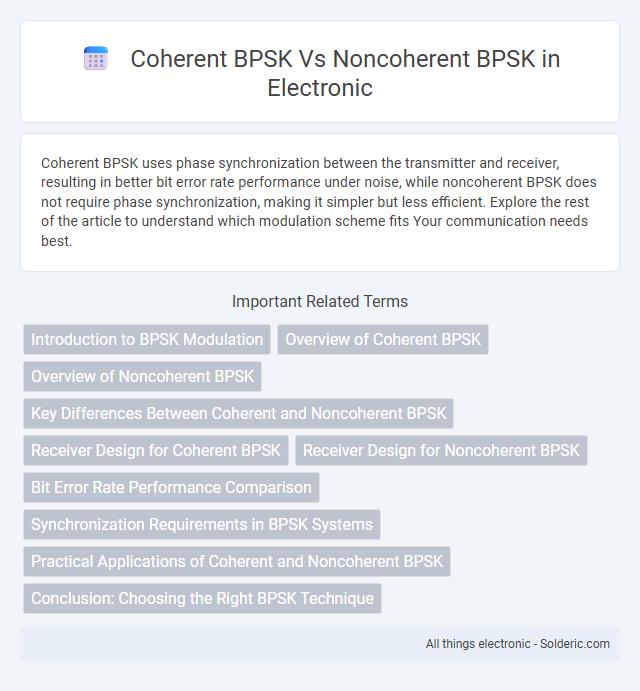Coherent BPSK uses phase synchronization between the transmitter and receiver, resulting in better bit error rate performance under noise, while noncoherent BPSK does not require phase synchronization, making it simpler but less efficient. Explore the rest of the article to understand which modulation scheme fits Your communication needs best.
Comparison Table
| Feature | Coherent BPSK | Noncoherent BPSK |
|---|---|---|
| Detection Method | Requires phase reference (carrier synchronization) | No phase reference needed (envelope detection) |
| Bit Error Rate (BER) | Lower BER; ideal: Q((2Eb/N0)) | Higher BER; typical: 0.5 * exp(-Eb/N0) |
| Complexity | Higher due to carrier phase recovery | Lower complexity, simpler demodulator |
| SNR Requirement | Approximately 3 dB better than noncoherent | Requires higher SNR for same BER |
| Synchronization | Strict, needs exact carrier phase alignment | Lenient, phase variations tolerated |
| Application | High-performance communication (e.g., satellite, RF links) | Low-complexity systems, fading channels |
Introduction to BPSK Modulation
Binary Phase Shift Keying (BPSK) is a fundamental digital modulation scheme that transmits data by shifting the carrier wave's phase between two distinct states, representing binary 0 and 1. Coherent BPSK requires precise carrier phase synchronization at the receiver to accurately demodulate the signal, ensuring optimal bit error rate performance in noisy channels. Noncoherent BPSK, by contrast, eliminates the need for carrier phase knowledge, simplifying receiver design but typically resulting in higher error rates, making it suitable for scenarios where phase synchronization is challenging or unnecessary.
Overview of Coherent BPSK
Coherent BPSK employs phase synchronization between the transmitted signal and the receiver's local oscillator to enable precise phase detection, enhancing error performance. It relies on exact carrier phase information to demodulate the signal accurately, resulting in a lower bit error rate compared to noncoherent BPSK. This modulation scheme is widely used in digital communication systems where phase synchronization is feasible, providing robust data transmission over noisy channels.
Overview of Noncoherent BPSK
Noncoherent BPSK detects phase-shift keying signals without requiring exact carrier phase synchronization, making it suitable for environments with rapid phase changes or uncertain carrier phase. This method relies on envelope detection or differential encoding to recover data, trading off some performance compared to coherent BPSK, which uses phase-locked loops for precise carrier reference. Your choice between noncoherent and coherent BPSK depends on system complexity, channel conditions, and required error performance.
Key Differences Between Coherent and Noncoherent BPSK
Coherent BPSK relies on phase synchronization between the transmitter and receiver, enabling precise detection of the signal phase and resulting in lower bit error rates compared to noncoherent BPSK. Noncoherent BPSK eliminates the need for phase synchronization by using energy detection, which simplifies receiver design but typically sacrifices performance in terms of sensitivity and error probability. Understanding these key differences helps optimize your communication system's design based on performance requirements and complexity constraints.
Receiver Design for Coherent BPSK
Receiver design for coherent BPSK relies on precise carrier phase synchronization between the transmitter and receiver to achieve optimal demodulation performance. The coherent detector multiplies the received signal by a locally generated carrier signal with matching phase and frequency, enabling effective symbol detection through correlation techniques. This approach significantly reduces bit error rates compared to noncoherent BPSK, which does not require phase synchronization but suffers from lower sensitivity and higher error probabilities.
Receiver Design for Noncoherent BPSK
Noncoherent BPSK receiver design avoids phase synchronization by employing envelope or energy detection methods, simplifying hardware compared to coherent detection which requires carrier phase reference. It primarily relies on differential detection or noncoherent correlation techniques to decode signals without exact carrier phase information, enhancing robustness in fast-fading channels. Your system benefits from relaxed complexity and lower power consumption, though at a trade-off of slightly reduced sensitivity and increased bit error rate relative to coherent BPSK receivers.
Bit Error Rate Performance Comparison
Coherent BPSK demonstrates significantly lower bit error rates compared to noncoherent BPSK due to its use of phase synchronization between the transmitter and receiver, enabling accurate demodulation of phase information. Noncoherent BPSK sacrifices some performance for simplicity by detecting signal energy without phase reference, resulting in roughly twice the bit error probability under the same signal-to-noise ratio conditions. Your communication system benefits from coherent BPSK when higher reliability is critical, but noncoherent BPSK suits scenarios with lower complexity and robustness requirements.
Synchronization Requirements in BPSK Systems
Coherent BPSK systems require precise carrier phase synchronization to demodulate signals accurately, relying on phase-locked loops or pilot signals for carrier recovery. Noncoherent BPSK systems eliminate the need for exact phase synchronization by using differential encoding and detection, which simplifies receiver design and improves robustness in phase-varying environments. Synchronization complexity in coherent BPSK often results in higher system cost and power consumption compared to the more tolerant noncoherent BPSK receivers.
Practical Applications of Coherent and Noncoherent BPSK
Coherent BPSK offers superior bit error rate performance and is widely used in modern satellite communications, deep-space telemetry, and fiber-optic systems where phase synchronization is achievable. Noncoherent BPSK is preferred in mobile and fading environments like wireless sensor networks and low-power IoT devices, where rapid phase variations make coherent detection challenging. Practical deployment depends on the trade-off between system complexity, power consumption, and channel conditions, with coherent BPSK suited for stable channels and noncoherent BPSK favored in dynamic, multipath-affected environments.
Conclusion: Choosing the Right BPSK Technique
Coherent BPSK offers superior bit error rate performance due to precise phase synchronization, making it ideal for applications demanding high reliability and low noise environments. Noncoherent BPSK, while simpler to implement and more robust against phase uncertainties, results in higher error rates but suits scenarios with rapid channel variations or limited receiver complexity. Selecting between coherent and noncoherent BPSK hinges on system constraints such as synchronization capability, computational resources, and acceptable error performance.
coherent BPSK vs noncoherent BPSK Infographic

 solderic.com
solderic.com